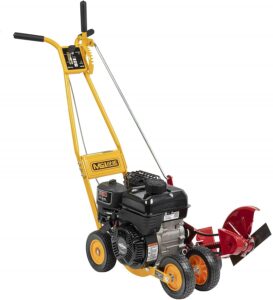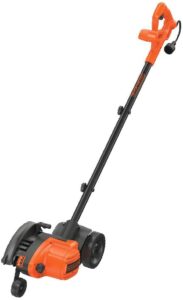Best Edgers
Best Gas Edger

Best Electric Edger

Best Hand Edger
Why do you need an edger?
Like we said above, keeping your grass edges clean and tidy makes an enormous difference in the overall look of your yard. And sadly, your lawn mower isn’t going to be able to take care of those for you, you’ll need an edger.
Edging isn’t just for looks, though. Grass can grow into your landscaping and even over the edges of pavement if left alone for too long. Edging stops this from happening by creating a root barrier that the grass can’t cross to ‘invade’ those unwanted spaces.
How to choose the best edger for your lawn
Engines
Electric or battery: These edgers don’t need fuel or oil to operate. They either need a battery if cordless or they’ll plug into an electrical outlet. A battery-operated edger isn’t as powerful as a corded edger, but they allow you to trim anywhere without needing to be near an outlet — and vice versa for corded edgers with more power but less mobility. Electric edgers are usually a more budget-friendly option and are great for people with smaller outdoor spaces.
Gas-powered: Gas lawn edgers are more powerful than electric and have better versatility for creating an overall polished yard. They are quicker and much more efficient than electric units so you can cover more space in less time, making them ideal for larger yards. Gas edgers come in either a two- or four-cycle format — two-cycle gas edgers are typically more powerful, cheaper, and weigh less than a four-cycle, but they aren’t nearly as efficient or environmentally conscious. Four-cycle edgers will weigh more and cost you more upfront, but are much more efficient and cause less pollution than two-cycle edgers.
Manual: Hand edgers are easy to control and are great for those hard-to-navigate spaces that an electric or gas powered edger might not be able to reach. You don’t have to worry about maintenance (other than an occasional blade sharpening or cleaning) and they can last for generations. You also don’t have to worry about accidentally dinging up your sidewalk or flower beds, unlike with an engine-powered blade. That being said, a manual edger is much more labor-intensive and much slower to use if you want to cover a lot of ground.
Wheels
While some edgers are light enough to carry and use on their own, edging an entire yard or large space can be straining on your arms and back. A lot of edgers come with wheels to help guide it along its paths and make the whole process less cumbersome. The most popular wheel design is with three wheels — two wheels in the back and a guide wheel up front. If you want some more stability while you edge, pick a four-wheeled edger instead. Having two wheels in the front and the rear will give it extra balance.
Blades
A straight, flat blade can handle basic edging jobs and simple yards just fine, but if you have complex landscaping it may be beneficial to invest in an edger with multiple settings or more advanced blades. Flat blades with scoop-cut edges can handle more delicate features, like flower beds, without fear of them being damaged by flying debris. These are also ideal for when the lawn or other surfaces are uneven. There are also star-shaped blades that can edge against a wall or a fence without dinging the blades or the wall.
Best Gas Edger

This gas edger by McLane will make your yard or outdoor space look tidy and clean using a single-level blade clutch and optimal depth control to get your desired cut. The blade edges both vertically and horizontally and can easily be tilted to almost any angle for those tough-to-reach spots. Edging will be a breeze thanks to the wide rubber tires and ball bearing wheels, giving it the ability to ride on most curbs while still delivering the perfect cut.
Best Electric Edger

This electric edger by Black + Decker is run by a 12-amp high torque motor to tackle virtually any overgrown lawn. A three-position blade adjustment design gives you the versatility you need to reach every spot in your yard. It also can easily convert from an edger to a landscape trencher to dig defined trenches around garden beds, trees, and other borders. This edger has an easy tool-free assembly and can be used by both right- and left-handed individuals, making it a great flexible option for any homeowner.
Best Hand Edger
This convenient manual edger by Truper is durably designed with North American Ash, a lacquered handle, and a clear-coated steel head to last you for years. It keeps sidewalks and other straightaways clean and clear of grass and weeds using a single guide wheel for ease. Easily clean the edger off when you’re done by spraying it off with the hose and protecting it with a silicone spray for storage.
FAQs about Edgers
Are edgers and trimmers the same thing?
No, they are separate tools. Edgers are designed to cut edges and create boundary lines in your yard, while string trimmers are designed to maintain those edges and lines. There are also 2-in-1 tools that can be used as both edgers and trimmers.
How often do I need to trim my lawn?
The main rule of mowing and cutting your yard is to never cut more than one-third of the blade. Usually, this means about once a week.
How close should my edger be to the grass?
The edger should be within about 1 inch of the edge of the lawn, flower bed, etc. that you’re edging around. Anything farther away than that will cause a noticeable line through your yard.
When is the best time to edge my lawn?
Aim to edge your lawn while the soil is damp — it’ll make maneuvering easier and do less damage on blades than on dry, hard ground.

